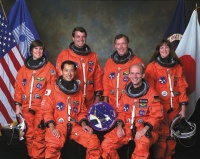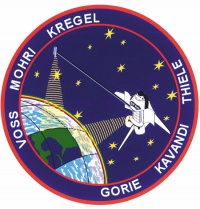STS-99
From The Space Library
 | |
| Organization | NASA-Office of Space Flight (United States) |
|---|---|
| Mission type | Earth Science |
| Launch date | February 11, 2000 |
| Launch vehicle | Space Shuttle |
| Launch site | Cape Canaveral, United States |
| COSPAR ID | 2000-010A |
| Inclination | 57 degrees |
| Experiments | Here |
| Alternate Names | 26088 |
| Additional Information | Here |
| Data Collection | Here |
| Payload Mass Up | 13600 kg |
| Payload Mass Down | 13063.64 kg |
| Orbiter | Endeavour |
| Lift Off Mass | 2,054,734.09 kg |
| Orbiter Weight at Liftoff | 116,618.18 kg |
| Orbiter Weight at Landing | 102,576.82 kg |
| Landed | Concrete runway 33 at Kennedy Space Center, Fla. |
| Orbits of Earth | 182 |
| Orbital Altitude | 126 nautical miles (145 statute miles) |
Contents |
[edit] Crew
- Commander: Kevin R. Kregel
- Pilot: Dominic L. Gorie
- Payload Commander:
- Mission Specialist 1: Gerhard P.J. Thiele
- Mission Specialist 2: Janet L. Kavandi
- Mission Specialist 3: Janice Voss
- Mission Specialist 4: Mamoru Mohri
- Mission Specialist 5:
- Payload Specialist 1:
- Payload Specialist 2:
ISS/Mir Crew Transport
[edit] Mission
STS 99 is an American shuttle spacecraft that was launched from Cape Canaveral at 17:43 UT. The main mission was to obtain a 3-D map of about 70% global terrain. It is a joint mapping mission by NASA and the National Imagery and Mapping Agency (NIMA), utilizing the Shuttle Radar Topography Mission (SRTM) radars. The 13,600 kg SRTM instrument consisted of a pair of transmit/receive antennas below the cargo bay, and a pair of receiving antennas at the end of a 60 m "rigid" tower. The operation was in interferometric synthetic aperture radar (IF-SAR) modes with steerable C-band (5.6 cm) and a non-steerable X-band (3.0 cm) transmissions of pulse widths 100 milliseconds, and power levels 10 kW. The accuracy of the mapping was modest: in any "terrain" segment, the relative height accuracy was 10 m and the relative horizontal accuracy was 20 m; on forests, the surface of reflection at both frequencies were the canopy tops, not the terrain. The tower was an assembly of stacked cubical frames made of steel, titanium and plastic, initially contained in a three meter can, pushed out by a motor and held in rigid shape by a thruster at the high end. It was erected at an angle of 450 from the vertical. The cargo bay antennas and the transmitters were the same that were used in the SIR-C/X-SAR radars that were flown on two shuttle missions in 1994. SRTM just had additional receiving antennas at the end of the mast to do interferometry. It landed back in Cape Canaveral on 22 February at 23:22 UT after mapping 112 million square-kilometers of the Earth's land mass onto 300 digital tapes. Data reduction at analysis centers will take two or three years to complete. More information on SRTM is available at http://www.jpl.nasa.gov/srtm/ and the data will be distributed by the EROS Data Center, http://edc.usgs.gov/.
[edit] EVA
[edit] Payload
Shuttle Radar Topography Mission hardware (mast, antenna, and data recording, processing products)
[edit] Books about the Space Shuttle Program
Buy This Book Click here |
Buy This Book here |
Buy This Book Click here |
Buy This Book Click here |





